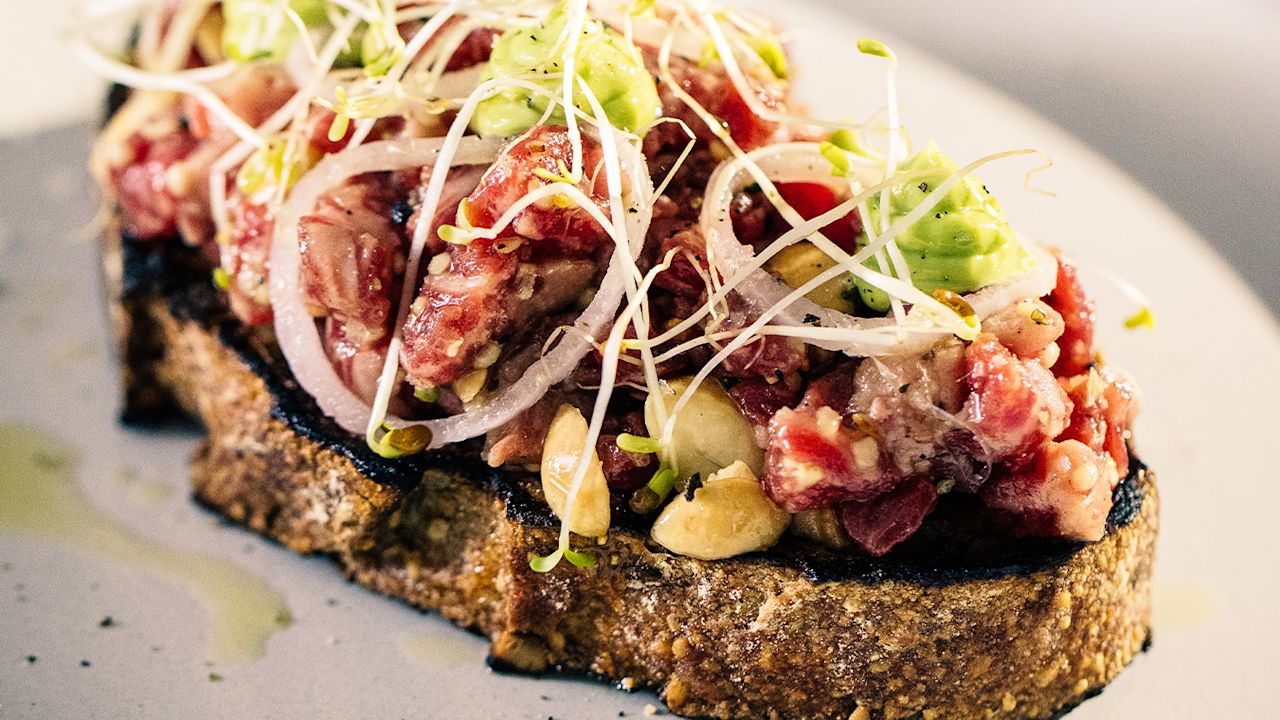

Chris Cosentino's Wagyu Tenderloin Tartare, Sprouts and "Hayaioli"

Chris Cosentino
Chris Cosentino
Chef and adventurer, Chris Cosentino co-owns Acacia House in Napa Valley, California, and Rosalie in Houston, Texas. He’s known for his focus on sustainability and whole animal cookery. “Inspiration is everywhere,” he says. “It comes from walking through a museum and seeing a unique brush stroke or a mobile moving with just enough wind from the people walking by. For me, it's riding my bike. I will smell wild fennel, see fresh bay leaves, pick beautiful spruce tips. Those things make my brain move, they trip a switch.”
The tenderloin tail can be a bit overlooked but it makes a great tartare. Whether I chop it or hand-grind it, I don’t muck about with the meat too much. A lot of times when people are grinding meat, they mix in all the fat and it starts to coat the meat. You lose the flavour on the palate. The way I do it is clean, it keeps the integrity of the meat and the fat.
With the accompaniments, I’m thinking about what the animal eats. We have a nice thick slab of multigrain bread made with grains the animal eats and our ‘hayaioli’ is an aioli but made with wheatgrass to pick up on the hay the cows chew on. That’s why the alfalfa is there too: if you let the sprouts keep growing, they become hay. And I use toasted almonds because the Westholme wagyu feed includes almond hulls. It’s texture and flavour but it’s also fun.
Ingredients
Tartare
Tartare
340g / 12 oz Westholme tenderloin tail
10g hemp seeds, toasted
15g Marcona almonds, toasted, chopped
2g Jacobsen sea salt
2g freshly ground black pepper
1 lemon, grated zest
2 tsp sorghum vinegar
3 tsp extra virgin olive oil
4 thick slices whole-wheat seeded rustic bread, grilled
Hayaioli
¼ cup pickled shallots
¼ cup alfalfa sprouts
Hayaioli
Hayaioli
15g garlic cloves, peeled
4g kosher salt
2 egg yolks
5g Dijon mustard
30g olive oil
244g wheatgrass oil
10g boiled russet potato
2g ground black pepper
Wheatgrass Oil
Wheatgrass Oil
1½ cups wheatgrass
23g kosher salt
1 cup extra virgin olive oil
Pickled Shallots
Pickled Shallots
2 shallots
224g red wine vinegar
5g peppercorns
28g sugar
10g salt
1 bay leaf
1 sprig thyme
Method

Tartare
Hand cut the tail of the tenderloin into ½ cm (¼ in.) dice, saving the rest of the tenderloin for another dish.
Add toasted hemp seeds and chopped almonds then mix gently in a bowl over a bowl of ice to prevent the fat from smearing. Season with salt, pepper, lemon zest to taste and mix. Add sorghum vinegar and olive oil.
To serve, spread the tartare on the grilled bread and dot with Hayaioli and pickled shallots and then top with alfalfa sprouts. Finish with a grind of black pepper and some sea salt.

Hayaioli
Pound garlic with salt in mortar and pestle until it forms a paste.
Add egg yolks and mustard and stir with pestle until combined.
Slowly drizzle in 30g of olive oil, stirring vigorously with pestle. Once aioli begins to emulsify, transfer to a food processor and add the potato then slowly add in the wheatgrass oil. Incorporate all oil and adjust the seasoning with salt and pepper.
Wheatgrass Oil
Blanch the wheatgrass until super bright green in a pot of well-salted boiling water, just for a few seconds, then shock it in ice water. Drain and pat dry with towels.
Place the wheatgrass and olive oil in a blender and blend until smooth.
Strain the oil through a fine mesh strainer, layered with a cheesecloth.
Store in an airtight container in the refrigerator until needed. This will keep for over a week but it’s best when it’s fresh.
Pickled Shallots
Using a mandolin, shave the peeled shallots into a non-reactive container.
On the stove over medium heat, in a non-reactive pot, heat the vinegar, sugar, spices and salt to a quick boil then cool.

"Whether I chop it or hand-grind it, I don’t muck about with the meat too much."
– Chef Chris Cosentino


